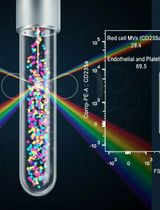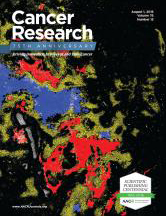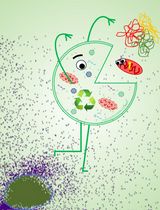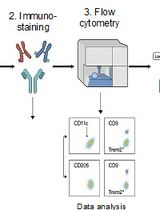- EN - English
- CN - 中文
Isolation of Mononuclear Cell Populations from Ovarian Carcinoma Ascites
从卵巢癌腹水中分离单核细胞群
发布: 2017年04月05日第7卷第7期 DOI: 10.21769/BioProtoc.2219 浏览次数: 11072
评审: Lee-Hwa TaiJalaj GuptaRalph Bottcher

相关实验方案

外周血中细胞外囊泡的分离与分析方法:红细胞、内皮细胞及血小板来源的细胞外囊泡
Bhawani Yasassri Alvitigala [...] Lallindra Viranjan Gooneratne
2025年11月05日 419 阅读
Abstract
Ovarian cancer is one of the most fatal tumors in women. Due to a lack of symptoms and adequate screening methods, patients are diagnosed at advanced stages with extensive tumor burden (Jelovac and Armstrong, 2011). Interestingly, ovarian cancer metastasis is generally found within the peritoneal cavity rather than other tissues (Lengyel, 2010; Tan et al., 2006). The reason behind this tissue tropism of the peritoneal cavity remains elusive. A prominent feature of this selectivity is ascites, the accumulation of fluid within the peritoneal cavity, containing, amongst others, immune cells, tumor cells and various soluble factors that can be involved in the progression of ovarian cancer (Kipps et al., 2013). The protocol described here is used to isolate mononuclear cells from ascites to study the functionality of the immune system within the peritoneal cavity.
Keywords: Ovarian cancer (卵巢癌)Background
Gradient centrifugation using LymphoprepTM is a standard protocol to isolate peripheral blood mononuclear cells (PBMCs). We slightly adjusted the protocol, regarding the sample preparation and amount of washing steps, in order to isolate mononuclear cells from ascites.
Materials and Reagents
- 50 ml tubes (Greiner Bio One International, catalog number: 227261 )
- Cell strainer 100 μm (Corning, Falcon®, catalog number: 352360 )
- 5 ml pipette (VWR, catalog number: VWR612-3702 )
- 10 ml pipette (VWR, catalog number: VWR612-3700 )
- 25 ml pipette (VWR, catalog number: VWR612-3697 )
- 225 ml tubes (Corning, Falcon®, catalog number: 352075 )
- 5 ml polypropylene round-bottom tube (Corning, Falcon®, catalog number: 352063 )
- Pre-separation filter 30 μm (Miltenyi Biotec, catalog number: 130-041-407 )
- Türk’s solution (EMD Millipore, catalog number: 1092770100 )
- LymphoprepTM (Alere Technologies, Axis-Shield, catalog number: 1114547 )
- Trypan blue stain (Thermo Fisher Scientific, GibcoTM, catalog number: 15250061 )
- FcR blocking reagent (Miltenyi Biotec, catalog number: 120-000-442 )
- Antibodies
- Anti-CD45-V450 (BD, BD Biosciences, catalog number: 560367 )
- Anti-CD19-FITC (Dako Cytomation, catalog number: F0768 )
- Anti-CD20-FITC (BD, BD Biosciences, catalog number: 345792 )
- Anti-CD56-FITC (BD, BD Biosciences, catalog number: 345811 )
- Anti-CD1c-PE (BDCA1) (Miltenyi Biotec, catalog number: 130-090-508 )
- Anti-CD14-PerCP (BD, BD Biosciences, catalog number: 345786 )
- Anti-HLA-DR-PE-Cy7 (BD, BD Biosciences, catalog number: 335830 )
- Anti-CD4-APC-Cy7 (BD, BD Biosciences, catalog number: 557871 )
- Anti-CD3-BV510 (BD, BD Biosciences, catalog number: 563109 )
- Ethylenediaminetetraacetic acid (EDTA) (EMD Millipore, catalog number: 1084211000 )
- Bovine serum albumin (BSA) (Roche Diagnostics, catalog number: 10735108001 )
- Phosphate-buffered saline (PBS) (Braun Melsungen, catalog number: 362 3140 )
- X-VIVO 15 (Lonza, catalog number: BE02-060Q )
- Antibiotic/Antimycotic (AA) (Thermo Fisher Scientific, GibcoTM, catalog number: 15240062 )
- Human serum (HS) (Bloodbank Rivierenland)
- 0.5 M EDTA (see Recipes)
- 10% BSA (see Recipes)
- Diluting buffer (see Recipes)
- Wash buffer (see Recipes)
- Staining buffer (see Recipes)
- Medium (see Recipes)
Equipment
- Centrifuge (Hettich Instruments, model: Rotanta 460R )
- Cell sorter (BD, model: FACS Aria II)
- Magnetic stirrer (Heidolph instruments, model: MR Hei-Mix S )
Procedure
文章信息
版权信息
© 2017 The Authors; exclusive licensee Bio-protocol LLC.
如何引用
Wefers, C., Bakdash, G., Moreno Martin, M., Duiveman-de Boer, T., Torensma, R., Massuger, L. F. and de Vries, I. J. M. (2017). Isolation of Mononuclear Cell Populations from Ovarian Carcinoma Ascites. Bio-protocol 7(7): e2219. DOI: 10.21769/BioProtoc.2219.
分类
细胞生物学 > 细胞分离和培养 > 细胞分离
细胞生物学 > 基于细胞的分析方法 > 流式细胞术
您对这篇实验方法有问题吗?
在此处发布您的问题,我们将邀请本文作者来回答。同时,我们会将您的问题发布到Bio-protocol Exchange,以便寻求社区成员的帮助。
提问指南
+ 问题描述
写下详细的问题描述,包括所有有助于他人回答您问题的信息(例如实验过程、条件和相关图像等)。
Share
Bluesky
X
Copy link













